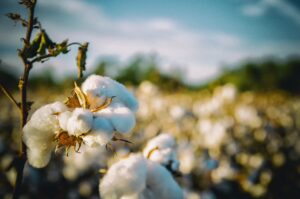COTTON
December cotton closed lower on Monday but managed to avoid testing the July 15 low at 82.54. A break below there would take the market to its lowest level since September 2021. The dollar index was lower for the fourth straight session, which may have helped cotton avoid a steeper selloff. The stock market and crude oil were also higher, which helps support cotton demand. The trade is worried that the threat of recession will hurt demand for cotton. High interest rates are expected to hurt the housing industry, which could also pressure cotton consumption, as new home buyers tend to buy a lot of furniture, curtains, bedding and other textiles.

COCOA
Cocoa prices were unable to extend their recovery move well above the 50-day moving average in spite of significant carryover support from key outside markets. While there has been some relief for near-term demand concerns, cocoa has received negative supply news at the start of this year. A “risk on” mood in many global markets included sizable gains for US stock markets and the British Pound, which provided a boost to cocoa prices as that can help to soothe near-term demand issues. There were reports that Ghana has not agreed to a farmgate price for the new 2022/23 season, however, and that weighed on cocoa market sentiment late in the day.
COFFEE
While global risk sentiment had a significant positive turnaround, coffee remained on the defensive as it posted a third negative daily result in a row. Bearish near-term supply remains a major source of pressure, and coffee may see further downside action before it can find its footing. A more than 4% rally in the Brazilian currency in the wake of Sunday’s general election provided coffee with early carryover support, as that should ease pressure on Brazil’s farmers to market their near-term supply to foreign customers. Rainfall over Brazil’s major Arabica growing regions was well above average last week, and that weighed on coffee prices late in the day as that should encourage additional flowering for their upcoming crop. The 2023/24 season is an “off-year” for Brazil’s biannual crop cycle that normally leads to lower production, and follows this season’s output which will have the second lowest total for the past nine “on-year” seasons.
SUGAR
Sugar prices have started the fourth quarter with a downside move in spite of significant carryover support from key outside markets. With the potential for a further bearish shift in the 2022/23 supply outlook, sugar should remain on the defensive. Strong rallies in crude oil and RBOB gasoline provide sugar prices with an early boost as an extended rebound in energy prices may help to strengthen ethanol demand. While the Brazilian currency had a huge daily rally in the wake of Brazil’s election results, news that incumbent President Bolsonaro made it to the run-off election later this month put significant pressure on sugar. Bolsonaro facilitated a sizable state tax cut in gasoline to boost his reelection chances, and Sunday’s results raises the prospects that current gasoline tax rates will be held in place once the election is over.
Futures and options trading involve significant risk of loss and may not be suitable for everyone. Therefore, carefully consider whether such trading is suitable for you in light of your financial condition. The information and comments contained herein is provided by ADMIS and in no way should be construed to be information provided by ADM. The author of this report did not have a financial interest in any of the contracts discussed in this report at the time the report was prepared. The information provided is designed to assist in your analysis and evaluation of the futures and options markets. However, any decisions you may make to buy, sell or hold a futures or options position on such research are entirely your own and not in any way deemed to be endorsed by or attributed to ADMIS. Copyright ADM Investor Services, Inc.
